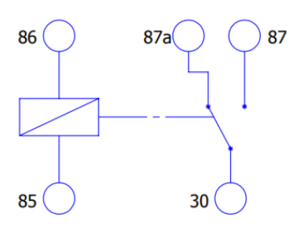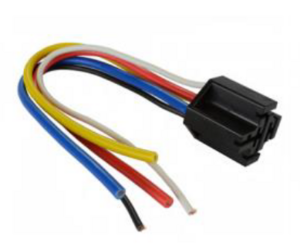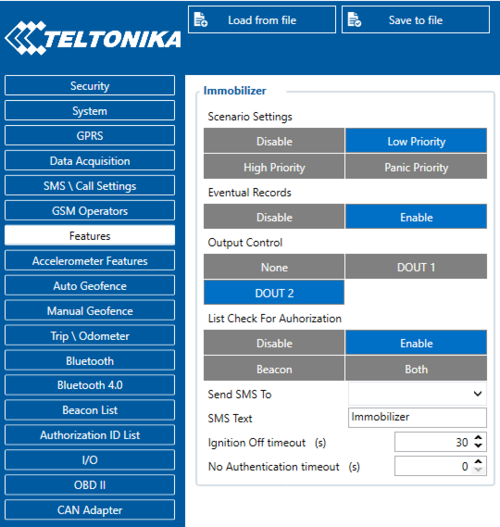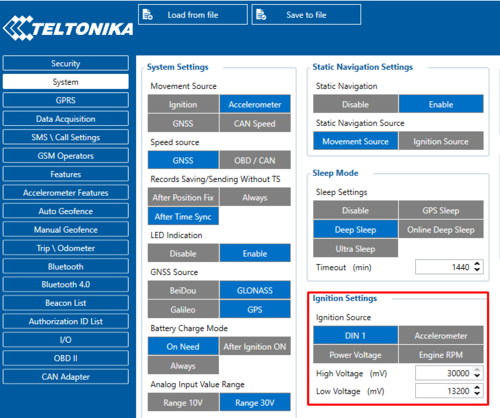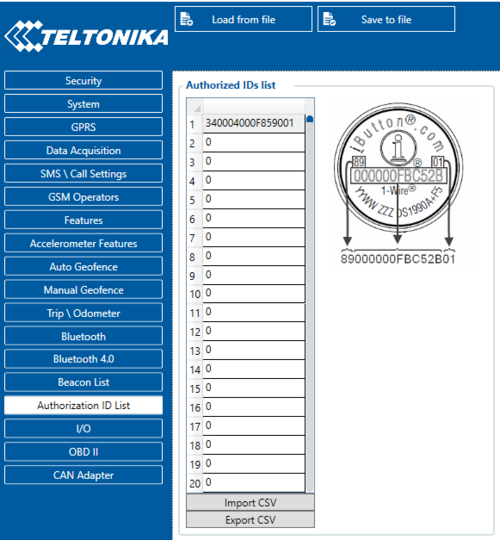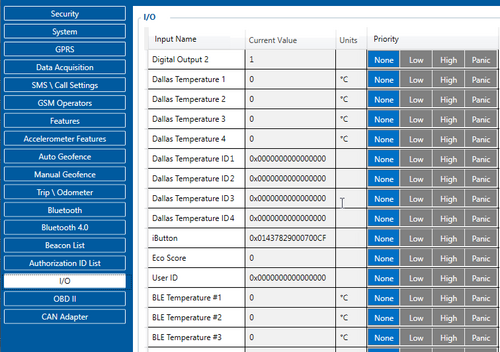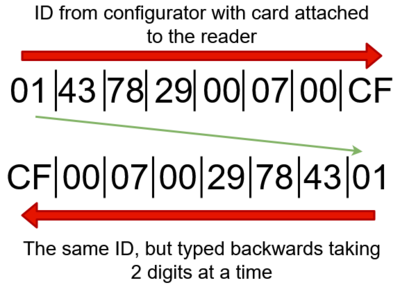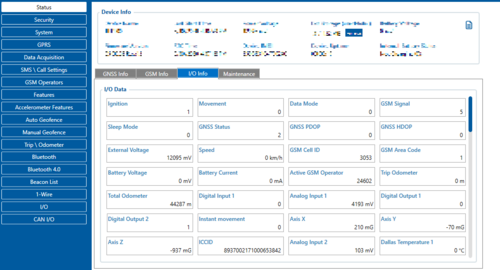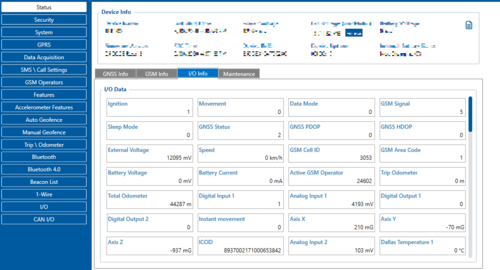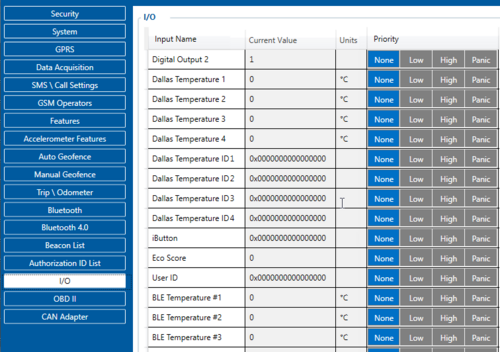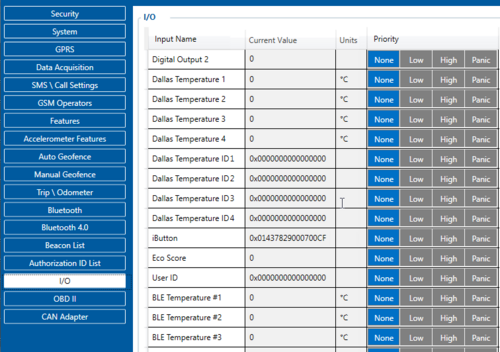Difference between revisions of "Automotive Relay"
| (34 intermediate revisions by 2 users not shown) | |||
| Line 1: | Line 1: | ||
| + | [[File:Relay Photo.png|Frame|Relay|300px|right]] | ||
__TOC__ | __TOC__ | ||
=Introduction to the product= | =Introduction to the product= | ||
| − | Automotive | + | Automotive relay can be used for immobilizer scenario, when the driver will have to be identificated in order to start the engine. Тhe advantages of a relay are that even if the thieves managed to bypass the cars alarm system by using modern jammers, they won't be able to start the engine. |
| + | <br> | ||
| − | |||
| − | |||
| − | |||
| − | |||
| − | |||
=Product Specification= | =Product Specification= | ||
[[Image:Relay scheme.png|thumb|Relay schematic diagram|300px|right]] | [[Image:Relay scheme.png|thumb|Relay schematic diagram|300px|right]] | ||
| Line 52: | Line 49: | ||
| style="border: 1px solid white; border-bottom: 2px solid #E8E8E8; text-align: left; vertical-align: center; background: white;" |Weight | | style="border: 1px solid white; border-bottom: 2px solid #E8E8E8; text-align: left; vertical-align: center; background: white;" |Weight | ||
| style="border: 1px solid white; border-bottom: 2px solid #E8E8E8; text-align: left; vertical-align: center; background: white;" |40g | | style="border: 1px solid white; border-bottom: 2px solid #E8E8E8; text-align: left; vertical-align: center; background: white;" |40g | ||
| − | |||
| − | |||
| − | |||
|- | |- | ||
|} | |} | ||
=Installation= | =Installation= | ||
| + | [[Image:Relay wiring.png|thumb|Relay Wiring|300px|right]] | ||
| + | |||
| + | In order to control vehicle starter via relay you will need a FM device that has a DOUT (Digital Output). | ||
| + | <br> | ||
| + | For different scenarios you can use iButton, RFiD, Beacons or simply control the DOUT via SMS/GPRS commands using your phone. | ||
| + | <br> | ||
| + | First of all you need to cut off the starter control cable and connect relay between starter cable and the engine. | ||
| + | <br> | ||
| + | Then connect FM device DOUT to the relay and 1-wire to iButton reader. | ||
{| class="wikitable" | {| class="wikitable" | ||
|+ | |+ | ||
| − | ! style="width: | + | ! style="width:40%; border: 1px solid white; border-bottom: 2px solid #0054A6; background: white; color: #0054A6; text-align: left;" |Relay PIN |
| − | ! style="width: | + | ! style="width:40%; border: 1px solid white; border-bottom: 2px solid #0054A6; background: white; color: #0054A6; text-align: left;" |Relay cable color |
| − | ! style="width:40%; border: 1px solid white; border-bottom: 2px solid #0054A6; background: white; color: #0054A6; text-align: left;" | | + | ! style="width:40%; border: 1px solid white; border-bottom: 2px solid #0054A6; background: white; color: #0054A6; text-align: left;" |Connects to |
|- | |- | ||
| style="border: 1px solid white; border-bottom: 2px solid #E8E8E8; text-align: left; vertical-align: center; background: white;" |30 | | style="border: 1px solid white; border-bottom: 2px solid #E8E8E8; text-align: left; vertical-align: center; background: white;" |30 | ||
| style="border: 1px solid white; border-bottom: 2px solid #E8E8E8; text-align: left; vertical-align: center; background: white;" |<span style="color:blue"><b>Blue</b></span> | | style="border: 1px solid white; border-bottom: 2px solid #E8E8E8; text-align: left; vertical-align: center; background: white;" |<span style="color:blue"><b>Blue</b></span> | ||
| − | | style="border: 1px solid white; border-bottom: 2px solid #E8E8E8; text-align: left; vertical-align: center; background: white;" | | + | | style="border: 1px solid white; border-bottom: 2px solid #E8E8E8; text-align: left; vertical-align: center; background: white;" |To Engine |
|- | |- | ||
| style="border: 1px solid white; border-bottom: 2px solid #E8E8E8; text-align: left; vertical-align: center; background: white;" |85 | | style="border: 1px solid white; border-bottom: 2px solid #E8E8E8; text-align: left; vertical-align: center; background: white;" |85 | ||
| style="border: 1px solid white; border-bottom: 2px solid #E8E8E8; text-align: left; vertical-align: center; background: white;" |<span style="color:black"><b>Black</b></span> | | style="border: 1px solid white; border-bottom: 2px solid #E8E8E8; text-align: left; vertical-align: center; background: white;" |<span style="color:black"><b>Black</b></span> | ||
| − | | style="border: 1px solid white; border-bottom: 2px solid #E8E8E8; text-align: left; vertical-align: center; background: white;" | | + | | style="border: 1px solid white; border-bottom: 2px solid #E8E8E8; text-align: left; vertical-align: center; background: white;" |DOUT |
|- | |- | ||
| style="border: 1px solid white; border-bottom: 2px solid #E8E8E8; text-align: left; vertical-align: center; background: white;" |86 | | style="border: 1px solid white; border-bottom: 2px solid #E8E8E8; text-align: left; vertical-align: center; background: white;" |86 | ||
| style="border: 1px solid white; border-bottom: 2px solid #E8E8E8; text-align: left; vertical-align: center; background: white;" |<span style="color:#eaecf0 "><b>White</b></span> | | style="border: 1px solid white; border-bottom: 2px solid #E8E8E8; text-align: left; vertical-align: center; background: white;" |<span style="color:#eaecf0 "><b>White</b></span> | ||
| − | | style="border: 1px solid white; border-bottom: 2px solid #E8E8E8; text-align: left; vertical-align: center; background: white;" | | + | | style="border: 1px solid white; border-bottom: 2px solid #E8E8E8; text-align: left; vertical-align: center; background: white;" |To Car Battery |
|- | |- | ||
| style="border: 1px solid white; border-bottom: 2px solid #E8E8E8; text-align: left; vertical-align: center; background: white;" |87 | | style="border: 1px solid white; border-bottom: 2px solid #E8E8E8; text-align: left; vertical-align: center; background: white;" |87 | ||
| style="border: 1px solid white; border-bottom: 2px solid #E8E8E8; text-align: left; vertical-align: center; background: white;" |<span style="color:yellow"><b>Yellow</b></span> | | style="border: 1px solid white; border-bottom: 2px solid #E8E8E8; text-align: left; vertical-align: center; background: white;" |<span style="color:yellow"><b>Yellow</b></span> | ||
| − | | style="border: 1px solid white; border-bottom: 2px solid #E8E8E8; text-align: left; vertical-align: center; background: white;" | | + | | style="border: 1px solid white; border-bottom: 2px solid #E8E8E8; text-align: left; vertical-align: center; background: white;" |None |
|- | |- | ||
| style="border: 1px solid white; border-bottom: 2px solid #E8E8E8; text-align: left; vertical-align: center; background: white;" |87a | | style="border: 1px solid white; border-bottom: 2px solid #E8E8E8; text-align: left; vertical-align: center; background: white;" |87a | ||
| style="border: 1px solid white; border-bottom: 2px solid #E8E8E8; text-align: left; vertical-align: center; background: white;" |<span style="color:red"><b>Red</b></span> | | style="border: 1px solid white; border-bottom: 2px solid #E8E8E8; text-align: left; vertical-align: center; background: white;" |<span style="color:red"><b>Red</b></span> | ||
| − | | style="border: 1px solid white; border-bottom: 2px solid #E8E8E8; text-align: left; vertical-align: center; background: white;" | | + | | style="border: 1px solid white; border-bottom: 2px solid #E8E8E8; text-align: left; vertical-align: center; background: white;" |Starter |
|- | |- | ||
|} | |} | ||
| + | <br> | ||
| + | <youtube>gjuiJjAejWU</youtube> | ||
| + | |||
| + | =Device configuration= | ||
| + | For configuration example we will be using FMB120 and RFiD | ||
| + | |||
| + | 1. Connect your FMB120 device to power supply | ||
| + | |||
| + | * <span style="color:red"><b>Red</b></span> wire on the positive contact of the power supply | ||
| + | |||
| + | * <span style="color:black"><b>Black</b></span> wire on GND of the power supply | ||
| + | |||
| + | 2. Connect your device to PC and open FMB120 configurator software to configure required fields for Immobilizer scenario. | ||
| + | |||
| + | You need to configure your device to read iButton/RFID card data and set immobilizer settings correctly. | ||
| + | |||
| + | ==Immobilizer scenario configuration== | ||
| + | |||
| + | [[File:Immobilizer scenario configuration.png|500px|thumb|center]] | ||
| + | <p style="text-align:center;">'''Figure 1'''. FMB120 Immobilizer scenario configuration | ||
| + | |||
| + | <p style="text-align:left;"> Navigate to Features panel, locate Immobilizer feature and configure Immobilizer settings as shown in the Figure 1. <br> | ||
| + | 1. '''Scenario settings''' – When low priority event is triggered, device makes additional record with indication of event cause. <br> | ||
| + | 2. '''Eventual Records''' - Select "Enable". When "Enable" value is selected, scenario status will be sent to your server only when it is triggered. <br> | ||
| + | 3. '''Output Control''' - you need to select which DOUT will be activated. In this case Digital output 2 will be activated if event happens. <br> | ||
| + | 4. '''List Check For Authorization''' – this parameter lets the user use this scenario for authorization. | ||
| + | |||
| + | <br /> | ||
| + | |||
| + | ==System panel configuration== | ||
| + | |||
| + | [[File:System panel configuration.png|500px|thumb|center]] | ||
| + | <p style="text-align:center;">'''Figure 2'''. Ignition source configuration | ||
| + | |||
| + | <p style="text-align:left;"> Go to system tab and look at the Ignition Source. We recommend to use DIN 1 as ignition source for this scenario. | ||
| + | |||
| + | ==Authorized ID List== | ||
| + | |||
| + | [[File:Authorization ID List.png|500px|thumb|center]] | ||
| + | <p style="text-align:center;">'''Figure 3'''. Authorized ID List | ||
| + | |||
| + | <p style="text-align:left;">Go to Authorized ID List settings tab. There you can see Authorized IDs List which is used to enter authorized IDs codes. Codes are used to authenticate user in immobilizer scenario as shown in Figure 3. For example, if you enter the wrong RFID card ID here, you will not be able to deactivate configured digital output. Below you will see a guide for RFID card ID decoding. | ||
| + | |||
| + | ===How to decode RFID Card ID with Configurator=== | ||
| + | |||
| + | 1. Connect the device with RFID Card Reader to the computer using USB cable and open configurator. | ||
| + | |||
| + | 2. In the configurator, open „I/O“ tab and find iButton in the list | ||
| + | |||
| + | 3. Attach the RFID card to the RFID Card Reader and check what ID is generated under „Current Value“ column near iButton parameter.<br> | ||
| + | |||
| + | [[File:IO elements.png|500px|thumb|center]] | ||
| + | <p style="text-align:center;">'''Figure 4.''' iButton ID detection | ||
| + | <p style="text-align:left;">4. In our case, the generated ID when we attach the card is: 01437829000700CF. <br> | ||
| + | 5. To get the RFID Card ID in a proper format for list checking, type the ID from the back to front taking 2 digits at a time. (Figure 5.) | ||
| + | [[File:IButton ID decoding.png|400px|thumb|center]] | ||
| + | <p style="text-align:center;">'''Figure 5.''' iButton ID decoding | ||
| + | <p style="text-align:left;">6. The ID we get from Figure 5 (CF00070029784301) is the ID of our RFID Card that we need to use in iButton List. Enter the ID in iButton list. | ||
| + | <br /> | ||
| + | |||
| + | =Stage 2. Connecting device to relay and iButton/RFID reader= | ||
| + | |||
| + | 1. Connect FMB120to you power supply:<br> | ||
| + | |||
| + | * Connect FMB120 positive cable to positive power supply contact (red wire).<br> | ||
| + | |||
| + | * Connect FMB120 GND cable to GND power supply contact (black wire).<br> | ||
| + | |||
| + | 2. Take relay, and connect wires in this order:<br> | ||
| + | |||
| + | * 86 (White wire) connects to 12V cable (both, FMB120 and power supply) | ||
| + | |||
| + | * 85 Dout (Black) connects to DOUT 1 or 2 of FMB120 (in this instructions we will use DOUT2 purple cable) | ||
| + | |||
| + | * 87a (Relay red cable) Connects to DIN1 (yellow) of FMB120 | ||
| + | |||
| + | 3. Take iButton or RFiD card reader and connect their wires in this order. (in this case we use RFiD card reader)<br> | ||
| + | |||
| + | * Green cable connects to GND cable of FMB120 and power supply.<br> | ||
| + | |||
| + | * Brown cable connects to 12V cables, FMB120, power supply and Relay.<br> | ||
| + | |||
| + | * White cable connects to 1-wire (green) of FMB120<br> | ||
| + | |||
| + | 5. Connect micro USB cable to FMB120 and your computer. | ||
| + | |||
| + | 6. Turn on your power supply. | ||
| + | |||
| + | 7. Connect Blue cable of relay (30 starter control) to positive power supply contact using additional cable. | ||
| + | |||
| + | 8. Open the configurator and go to status window I/O info section. In Figure 7 you can see Ignition value is 1 and digital output 2 value is also 1, digital input 1 value should be 0 (if you connect relay to DOUT 1, then you will see the value in Digital output 1 section). | ||
| + | [[File:IO info blur.png|500px|thumb|center]] | ||
| + | <p style="text-align:center;">'''Figure 7'''. I/O info. Ignition | ||
| + | |||
| + | <p style="text-align:left;">In figure 7 you can see Ignition value is 1 and Digital output 2 value is also 1, digital input value should be 0 (if you connect relay to DOUT 1, then you will see the value in Digital output 1 section). <br> | ||
| + | |||
| + | 9. Touch RFID card with the RFID Card reader, and after that in the configurator status window you should see that Digital output 2 changed it’s value to 0 ant digital input changed it’s value to 1. As shown in Figure 8. <br> | ||
| + | |||
| + | [[File:IO info. Digital Input.png|500px|thumb|center]] | ||
| + | <p style="text-align:center;">'''Figure 8'''. I/O info. Digital Input | ||
| + | |||
| + | <p style="text-align:left;">10. To check if your RFID card reader or iButton works you can go to I/O window and find iButton parameter as shown in Figure 9. <br> | ||
| + | |||
| + | [[File:IButton ID.png|500px|thumb|center]] | ||
| + | <p style="text-align:center;">'''Figure 9'''. iButton ID | ||
| + | |||
| + | <p style="text-align:left;">When you touch the RFID card (or iButton) to RFID card (or iButton) reader these parameters should change to your iButton’s ID: | ||
| + | [[File:IButton ID 2.png|500px|thumb|center]] | ||
| + | <p style="text-align:center;">'''Figure 10'''. iButton ID<br> | ||
| + | |||
| + | <p style="text-align:left;">'''Operation example:'''<br> | ||
| + | |||
| + | When DOUT 2 value is 1, ignition is blocked and the vehicle will not be started. When the iButton/RFID card is attached to the reader, DOUT 2 value changes from 1 to 0 allowing you to start the transport normally. | ||
| − | |||
| − | |||
| − | |||
| − | |||
| − | |||
| − | |||
| − | |||
| − | |||
| − | |||
| − | |||
| − | |||
| − | |||
| − | |||
| − | |||
| − | |||
| − | |||
| − | |||
| − | |||
| − | |||
| − | |||
| − | |||
| − | |||
[[Category:Accessories]] | [[Category:Accessories]] | ||
Revision as of 11:41, 7 October 2021
Main Page > Accessories > Automotive RelayIntroduction to the product
Automotive relay can be used for immobilizer scenario, when the driver will have to be identificated in order to start the engine. Тhe advantages of a relay are that even if the thieves managed to bypass the cars alarm system by using modern jammers, they won't be able to start the engine.
Product Specification
| Name | Value |
|---|---|
| Contact Rating | 30A/40A 14VDC |
| Coil Voltage | 12VDC |
| Coil Power | 1.8W |
| Release Voltage | ≥10% |
| Pickup Voltage | ≤70% |
| Insulation Resistance | 100Ω |
| Contact Resistance | 100Ω |
| Between open contact | 500VAC |
| Between coil & contact | 750VAC |
| Temperature Range | -55~+85℃ |
| Dimension | 25.0x27.4x28.4 |
| Weight | 40g |
Installation
In order to control vehicle starter via relay you will need a FM device that has a DOUT (Digital Output).
For different scenarios you can use iButton, RFiD, Beacons or simply control the DOUT via SMS/GPRS commands using your phone.
First of all you need to cut off the starter control cable and connect relay between starter cable and the engine.
Then connect FM device DOUT to the relay and 1-wire to iButton reader.
| Relay PIN | Relay cable color | Connects to |
|---|---|---|
| 30 | Blue | To Engine |
| 85 | Black | DOUT |
| 86 | White | To Car Battery |
| 87 | Yellow | None |
| 87a | Red | Starter |
Device configuration
For configuration example we will be using FMB120 and RFiD
1. Connect your FMB120 device to power supply
- Red wire on the positive contact of the power supply
- Black wire on GND of the power supply
2. Connect your device to PC and open FMB120 configurator software to configure required fields for Immobilizer scenario.
You need to configure your device to read iButton/RFID card data and set immobilizer settings correctly.
Immobilizer scenario configuration
Figure 1. FMB120 Immobilizer scenario configuration
Navigate to Features panel, locate Immobilizer feature and configure Immobilizer settings as shown in the Figure 1.
1. Scenario settings – When low priority event is triggered, device makes additional record with indication of event cause.
2. Eventual Records - Select "Enable". When "Enable" value is selected, scenario status will be sent to your server only when it is triggered.
3. Output Control - you need to select which DOUT will be activated. In this case Digital output 2 will be activated if event happens.
4. List Check For Authorization – this parameter lets the user use this scenario for authorization.
System panel configuration
Figure 2. Ignition source configuration
Go to system tab and look at the Ignition Source. We recommend to use DIN 1 as ignition source for this scenario.
Authorized ID List
Figure 3. Authorized ID List
Go to Authorized ID List settings tab. There you can see Authorized IDs List which is used to enter authorized IDs codes. Codes are used to authenticate user in immobilizer scenario as shown in Figure 3. For example, if you enter the wrong RFID card ID here, you will not be able to deactivate configured digital output. Below you will see a guide for RFID card ID decoding.
How to decode RFID Card ID with Configurator
1. Connect the device with RFID Card Reader to the computer using USB cable and open configurator.
2. In the configurator, open „I/O“ tab and find iButton in the list
3. Attach the RFID card to the RFID Card Reader and check what ID is generated under „Current Value“ column near iButton parameter.
Figure 4. iButton ID detection
4. In our case, the generated ID when we attach the card is: 01437829000700CF.
5. To get the RFID Card ID in a proper format for list checking, type the ID from the back to front taking 2 digits at a time. (Figure 5.)
Figure 5. iButton ID decoding
6. The ID we get from Figure 5 (CF00070029784301) is the ID of our RFID Card that we need to use in iButton List. Enter the ID in iButton list.
Stage 2. Connecting device to relay and iButton/RFID reader
1. Connect FMB120to you power supply:
- Connect FMB120 positive cable to positive power supply contact (red wire).
- Connect FMB120 GND cable to GND power supply contact (black wire).
2. Take relay, and connect wires in this order:
- 86 (White wire) connects to 12V cable (both, FMB120 and power supply)
- 85 Dout (Black) connects to DOUT 1 or 2 of FMB120 (in this instructions we will use DOUT2 purple cable)
- 87a (Relay red cable) Connects to DIN1 (yellow) of FMB120
3. Take iButton or RFiD card reader and connect their wires in this order. (in this case we use RFiD card reader)
- Green cable connects to GND cable of FMB120 and power supply.
- Brown cable connects to 12V cables, FMB120, power supply and Relay.
- White cable connects to 1-wire (green) of FMB120
5. Connect micro USB cable to FMB120 and your computer.
6. Turn on your power supply.
7. Connect Blue cable of relay (30 starter control) to positive power supply contact using additional cable.
8. Open the configurator and go to status window I/O info section. In Figure 7 you can see Ignition value is 1 and digital output 2 value is also 1, digital input 1 value should be 0 (if you connect relay to DOUT 1, then you will see the value in Digital output 1 section).
Figure 7. I/O info. Ignition
In figure 7 you can see Ignition value is 1 and Digital output 2 value is also 1, digital input value should be 0 (if you connect relay to DOUT 1, then you will see the value in Digital output 1 section).
9. Touch RFID card with the RFID Card reader, and after that in the configurator status window you should see that Digital output 2 changed it’s value to 0 ant digital input changed it’s value to 1. As shown in Figure 8.
Figure 8. I/O info. Digital Input
10. To check if your RFID card reader or iButton works you can go to I/O window and find iButton parameter as shown in Figure 9.
Figure 9. iButton ID
When you touch the RFID card (or iButton) to RFID card (or iButton) reader these parameters should change to your iButton’s ID:
Figure 10. iButton ID
Operation example:
When DOUT 2 value is 1, ignition is blocked and the vehicle will not be started. When the iButton/RFID card is attached to the reader, DOUT 2 value changes from 1 to 0 allowing you to start the transport normally.

